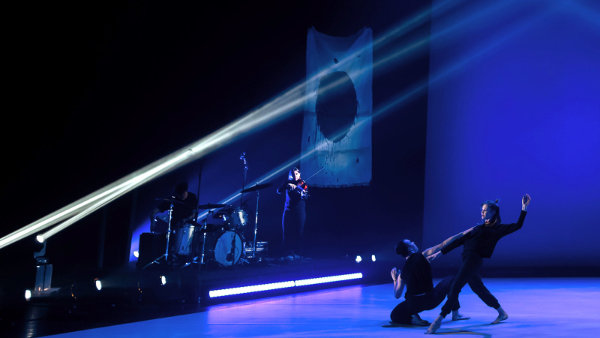
Peggy Baker was a memorably striking and unusual dancer during her years performing with Lar Lubovitch‘s company. Tall, powerful, seemingly gawky, with lashing limbs, she was never a pretty figure onstage, but more of an energized force field. After spending most of the 1980s with Lubovitch, she was invited to be part of the unique, high-class White Oak Dance Project, a singular collaborative venture shaped by Mikhail Baryshnikov and Mark Morris. They sought out experienced dancers who were strong individuals on stage, and Baker certainly fit in.
She eventually relocated to Toronto, where she curated and performed solo programs that she occasionally brought to a New York stage. After decades as a choreographic instrument, she became interested in “what would happen if I walked into a dance studio by myself and no one told me what to do,” she says during one of the frequent narrative portions interspersed throughout the 40-minute film.
Choreographing for others came later, after her own physical abilities began to decline, and after the death of her husband, who suffered from Multiple Sclerosis, left her initially fearful of venturing into the studio.
DANCING DARKNESS, the impressionistic, artfully edited film that is part of the Dance on Camera Festival, explores the process and ideas behind her large-scale recent work, Who We Are in the Dark. Her process is exploratory and instinctive, based on what we see and hear in the glimpses of her shaping the work on eight dancers and working with an impressive group of collaborators.
Baker’s musical choice – violinist Sarah Neufeld and drummer Jeremy Gara of the indie-rock group Arcade Fire – is particularly inspired, based on the tantalizing, reverberant excerpts heard during rehearsal and, towards the end, what appears to be performance footage. The rehearsals are shot in black and white with a lovely organic, unintrusive approach that draws the viewer into the process. The directors elegantly weave in glimpses and discussions of the visual elements (including projections on the floor that the dancers initially find disorienting) and the contributions of “vocalographer” Fides Krucker, who opens up the dancers’ voices as an integral aspect of the work. It’s a term Baker coined from her interest in “opening up the body as an instrument of sound” – as opposed to the more traditional dance approach of “muting the body.”
The film’s compact duration and fluid structure keep it intriguing. This is not a neat illustration and explanation of how and why a dance was conceived and made, but rather an evocation of the exploratory approach Baker takes as she draws movement out of her interesting ensemble of performers and enriches the work’s texture by her openness to collaboration.
DANCING DARKNESS Peggy Baker conjures ‘who we are in the dark’
Directed by V. Tony Hauser and Ellen Tolmie, Canada, 2020, 40m
Susan Reiter covers dance for TDF Stages and contributes regularly to the Los Angeles Times, Playbill, Dance Australia and other publications.
DANCING DARKNESS with Wendy Perron-moderated conversation with Hauser, Tolmie, and Baker | Saturday July 18, 4 pm Eastern, part of Dance on Camera Film Festival virtual festival July 17-20

Thank you, Julie!
re: photo
I am so glad for the clarification. There were so many paparazzi flashing bulbs in my eyes, I did not see that you got the money shot. Well done!
Just a shout out to Artsmeme for being the coolest blog on the planet and to its creator, Debra Levine. I really love it.
.
BTW, I took that pretty picture of Debra Levine in the orange dress and didn’t get photo credit.